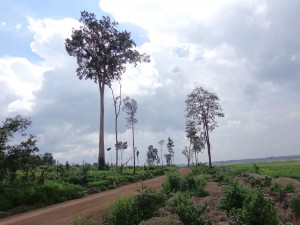More than $85 million worth of timber was exported from Cambodia to Vietnam during the first half of the year, according to Vietnamese customs data, despite a blanket ban Cambodia has placed on all timber exports to its eastern neighbor.
The National Military Police banned all timber trading with Vietnam in mid-January as part of a broad sweep of eastern Cambodia to root out illicit timber stocks, a tacit admission of the rampant illegal logging in the area—much of it for export.

Government officials say their efforts have all but wiped out illegal logging and timber exports in the area. Vietnam’s customs data for the first six months of the year, however, belies the claim.
According to the customs data, obtained by the U.S. NGO Forest Trends, Cambodia exported 88,000 cubic meters of sawn timber worth $71 million to Vietnam from the start of the year to the end of June. By both volume and value, that comes to a little more than half the sawn wood exported over the same period in 2015, a significant drop but nowhere near the shutdown avowed by Cambodia.
According to the same data, exports of unsawn logs skyrocketed from 6,000 cubic meters worth $1.5 million during the first half of last year to 58,000 cubic meters worth $15 million this year, a roughly 10-fold increase. Cambodia supposedly banned the export of unprocessed logs some 20 years ago.
The combined 94,000 cubic meters of exported wood officially recorded by Vietnam—the vast majority of it after the export ban imposed in mid-January—even laps the 71,000 cubic meters of illicit timber stocks that Cambodian officials claim they netted in their sweep of the eastern provinces.
Xuan Phuc, a regional trade and finance analyst for Forest Trends, said it was too soon to call the month-to-month rise in exports so far this year a trend.
“But what’s quite clear is that there are uncertainties that the [export ban] policy will work effectively in the long run,” he said. “Traders may wait for the sand to settle and take it up again.”
Mr. Phuc said the steep rise in log exports were probably not a reaction to Cambodia’s new ban on sawn wood because the two types of timber usually supplied different markets and involved different groups of traders. He said it probably had more to do with recent deregulation by Vietnam, which no longer asks its importers to secure permits from the country’s Ministry of Industry and Trade.
In any case, he said the continued flow of so much timber from Cambodia to Vietnam was very likely being greased by corruption and that Vietnam’s official customs data probably under-recorded the actual trade, “but we just don’t know how much.”
Eng Hy, spokesman for the National Military Police, which was put in charge of this year’s crackdown on illegal logging in eastern Cambodia, said he did not know how much timber had reached Vietnam since the ban took effect. He declined to comment on Vietnam’s customs data because he had not seen it for himself.
The Commerce Ministry has acknowledged that timber exports persist and blamed the ban’s modest impact on a lack of resources, which it called a “systemic weakness” hampering enforcement.
However, environmental groups and villagers who live along the border say police, military police, soldiers and border officials often collude with the loggers and traders to get the timber into Vietnam.
(Additional reporting by Aun Pheap)




